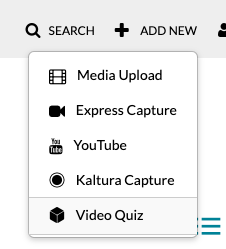Mar
2018
3rd IMS vodcast promotion of Kannan’s presentation
Third IMS vodcast: promotion of Kannan’s presentation on free tools
Kannan’s presentation on free tools available here:
Digital Literacy for St. Cloud State University
Third IMS vodcast: promotion of Kannan’s presentation on free tools
Kannan’s presentation on free tools available here:
My note:
I pushed this idea four years ago (e.g. https://youtu.be/4vw0iID0huE) for the SCSU library and it was shut down
http://www.davidleeking.com/rocking-the-small-screen-without-losing-your-mind
++++++++++++++++++++++++++++++
More on videos in the library in this IMS blog
https://www.chronicle.com/article/when-this-is-all-over-keep-recording-your-lectures
“Passively watching a recording is not as good as being an active participant in class, so these videos are a supplement, not a substitute. I’ll keep posting the videos as long as you keep coming to class.”
My note: I wonder if the instructor uses the “VideoQuiz” option in MediaSpace/Kaltura and place questions at important places of the h/er video lecture recording and thus make the experience more engaging
+++++++++++
more on vodcast in this IMS blog
https://blog.stcloudstate.edu/ims?s=vodcast
more on lecture capture in this IMS blog
https://blog.stcloudstate.edu/ims?s=video+lecture
Today’s vocast will be broadcasted live at:
Adobe Connect | Facebook Live | Twitter (#IMSvodcast) |
and will be archived at:
SCSU MediaSpace | YouTube (subscribe for the channel for future conversations)
Constructivism.
Student-centered learning theory and practice are based on the constructivist learning theory that emphasizes the learner’s critical role in constructing meaning from new information and prior experience.
+++++++++++++++
https://blog.stcloudstate.edu/ims/2018/02/12/first-ims-podcast-on-technology-in-education/
additional information at CETL web page: https://www.stcloudstate.edu/teaching/events/trtl.aspx
+++++++++++++++++++++++++++++++
+++++++++++++++++++++++++++++++++++++
archived session here: https://blog.stcloudstate.edu/ims/view-podcasts/
Every week, we will be presenting you in a short 5 min session with topics of your interest.
We will be providing you with information and giving you the podium to share your solutions.
This information will be broadcasted and archived via multiple channels:
The SCSU MediaSpace | On the Facebook IMS page | Twitter (#IMSvodcast) | YouTube
You can participate during the live session via
Adobe Connect: https://webmeeting.minnstate.edu/scsuteched,
Facebook and Twitter
Here is a Google form, where you can share your topics requests, issues and solutions.
vlog is simply a blog in video form. In a vlog, you can share anything you might do in a blog post, such as a tutorial or a story from your life.
Consistency is best for vlogging. If you post a vlog here and there, you won’t gain much traction.
the purpose of a vlog is to help people discover you. Videos that may be suitable for YouTube but that don’t help people discover you, such as a product commercial or an introduction to your company, don’t make great vlog posts. To be discovered, think of the users who are searching for a concern, a specialty, or the answer to a question. Think about what a potential customer or audience member might want to know, create a video about the topic, and upload it to YouTube.
What It Takes to Vlog
develop a strong message before you begin your video.
the camera is a vehicle delivering your message to people. When you talk to viewers the way you talk to another person, you do much better on camera.
ROI on Vlogging
the return on investment for vlogging, you need to focus on your goals. Don’t worry about vanity metrics such as followers, likes, and subscribers. Instead, measure what actually matters for your goals. For example, if your goal is to get clients, consider how many clients you need to acquire to make the hours you put into vlogging worthwhile.
goals and milestones are important for determining your ROI.
Consistency is another element for raising your channel’s profile on YouTube. If you post a video only here and there, you don’t consistently bring traffic and grow.
Examples of Great Vlogs
Gary Vaynerchuk, Casey Neistat,
+++++++++++++++
more on vlogs in this IMS blog:
https://blog.stcloudstate.edu/ims?s=vlog
more on vodcasting in this IMS blog:
https://blog.stcloudstate.edu/ims?s=podcasting